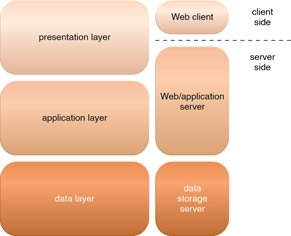Cloud Computing Patterns, Mechanisms > Basics > Web Technology > Web Applications
Web Applications
A distributed application that uses Web-based technologies (and generally relies on Web browsers for the presentation of user-interfaces) is typically considered a Web application. These applications can be found in all kinds of cloud-based environments due to their high accessibility.
Figure 1 presents a common architectural abstraction for Web applications that is based on the basic three-tier model. The first tier is called the presentation layer, which represents the user-interface. The middle tier is the application layer that implements application logic, while the third tier is the data layer that is comprised of persistent data stores.

Figure 1 – The three basic architectural tiers of Web applications.
The presentation layer has components on both the client and server-side. Web servers receive client requests and retrieve requested resources directly as static Web content and indirectly as dynamic Web content, which is generated according to the application logic. Web servers interact with application servers in order to execute the requested application logic, which then typically involves interaction with one or more underlying databases.
PaaS ready-made environments enable cloud consumers to develop and deploy Web applications. Typical PaaS offerings have separate instances of the Web server, application server, and data storage server environments.
Note
For more information about URLs, HTTP, HTML, and XML, visit www.servicetechspecs.com.
